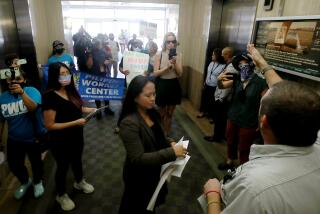The Benefit That Ate California: The Scandal of Workers’ Comp
At the turn of the century, California legislators created a system for employers to compensate workers injured on the job. Today that system is a mess.
California’s $10.4-billion workers’ compensation program is the third most costly system in the nation. But benefits to injured workers--up to $336 a week--rank a dismal 35th among the states. Meanwhile, the average charge for a medical evaluation--separate from treatment--was $1,200 in 1990. How is it that the payout to doctors is greater than benefits to injured workers? Because the California workers’ compensation system has become a distortion of what it was designed to be.
The existing high-cost, low-benefit system is unfair to both workers and California employers. Runaway medical and legal costs are hurting employers, be they mom-and-pop businesses or giant corporations or the public sector. With little control over these costs, some employers are leaving California. The system needs an overhaul. Costs must be contained, abuse and fraud curbed.
Past attempts at reform--in 1989 and, most recently, in budget negotiations last summer--have been piecemeal and woefully inadequate. We’re paying dearly for short-term quick fixes. The ultimate cost to us all--in dollars and job losses--will only increase if the system is left unchanged.
NOBLE GOALS: Until the early 1900s, employers assumed no liability for workers injured on the job. The only redress for injured workers was in the courts. In 1911, the Legislature enacted a voluntary plan of compensation benefits. In 1913, benefits were made compulsory, regardless of fault.
Workers are entitled to medical treatment and compensation payments--temporary, partial or permanent disability, vocational rehabilitation and death benefits--for injuries sustained on the job. Employers buy insurance to provide the benefits. Large companies are usually self-insured.
The no-fault system was designed to remove industrial accidents, with some exceptions, from the jurisdiction of civil courts and place them under the Workers Compensation Appeals Board. Over the years, industrialization, technology and the changing workplace have added new categories of jobs with different risks--physical and mental.
RISING COSTS: California is one of only six states that recognizes mental or emotional job stress even if it is not triggered by some extraordinary or sudden event. In fact, a person can actually file a job stress claim by simply asserting that being fired, whether justified or not, caused him stress. Reported mental stress claims have increased 700% in the last decade, compared to 17% for non-stress injuries.
The stress element makes workers’ compensation particularly vulnerable to abuse. A virtual cottage industry of worker compensation mills has flourished. They hire runners to recruit workers to file disability claims. Some doctors and lawyers even advertise in the media, encouraging workers to take advantage of workers’ compensation. The unsubtle message of many ads is unmistakable: “Don’t like your job? Boss too demanding? Sue!”
Even if a worker ultimately is deemed ineligible for benefits, doctors providing treatment typically are paid by the employer’s insurers.
When a claim--stress or non-stress--is valid, often there is a dispute on the extent of the disability on which benefits are based. An injured worker is sent to more than one doctor for medical evaluation. The result: Dueling doctors, who also are paid by the employer’s insurers.
And let’s not forget the major role of lawyers in this mess. The California Workers’ Compensation Institute reported 14.8% of all claims filed in the second quarter of this year were litigated. The average litigation cost in 1990 was $7,030 per case, with total litigation costs amounting to $1.5 billion. Lawyers typically draw 10% to 12% of a claimant’s award.
EMPLOYER BLUES: Workers’ compensation costs for California employers as a percentage of payroll was 3.075% in 1988--the latest year for which data is available. That is the second-highest, after Montana, and 53% greater than the national average. Average weekly cost per employee was the third-highest, 66% above the average of other states.
Legislation in 1989 raised benefits, provided some reform and added a requirement that at least 10% of a stress claim be related to the job. It also established the Industrial Medical Council, which has done a woefully inadequate job of developing standards for medical evaluation. Gov. Pete Wilson secured some changes last summer, including a requirement that a worker must be at a job for six months before making a claim and a crackdown on fraudulent practices and misleading ads.
Structural reform is key to controlling the runaway costs of workers’ compensation. Eligibility requirements must be tightened so that only injuries where work is the major contributing factor are compensable. Benefit categories should be examined, the “threshold” for stress claims should be redefined, redundancies in vocational rehabilitation and permanent disability benefits should be eliminated and insurance premiums should be reviewed.
Workers’ compensation is a proper and necessary cost of doing business. But if left unchanged, it will continue to be abused--robbing injured workers of the protection they deserve and employers of time and money better spent on contributing productively to our troubled state economy.
More to Read
Get the L.A. Times Politics newsletter
Deeply reported insights into legislation, politics and policy from Sacramento, Washington and beyond. In your inbox three times per week.
You may occasionally receive promotional content from the Los Angeles Times.










